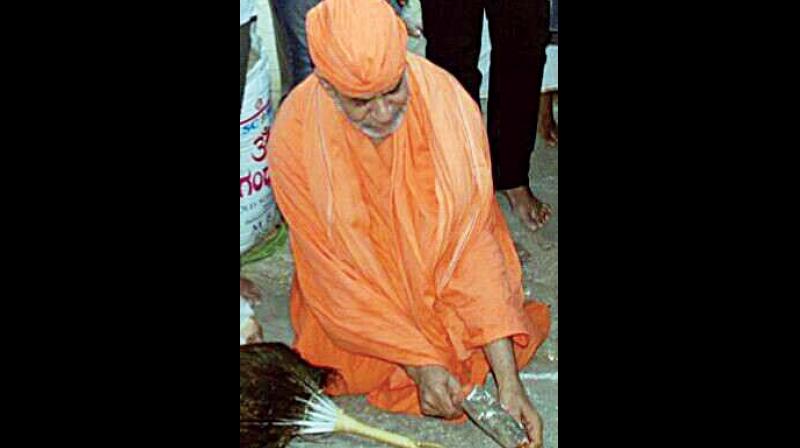Sculpting Bahubali: Gold chisel, silver hammer say it all

Hassan: A centuries old golden chisel and silver hammer, believed to have been used as a model to signify the massive effort which went into sculpting the gigantic statue of Bahubali in Shravanabelagola, Hassan, were on display for a special puja performed to carve out 400 new steps at the popular Jain pilgrimage centre in the Vindhyagiri Hills on Thursday.
The chisel and hammer, which have been preserved by the Jain Mutt in Shravanabelgola for generations, have been passed on to its pontiffs since 981 AD when the first mahamastakabhisheka (head anointing ceremony) of Bahubali was performed during the time of Chavundaraya, the PM of the Ganga dynasty that ruled the region. The mutt also has a golden paduke (footwear) and a royal ring among other antiques from the era in its possession.
The new 400 steps being built by the ASI in Vindhyagiri hills to reach the statue of Bahubali, are each five feet long and one- and- half feet wide. Located close to the existing steps used by devotees to get to the statue, they are being built at the request of the mutt to cater to the growing number of pilgrims visiting the religious centre. The steps are expected to be ready by February 2018.
“We cannot build any more steps in future as there is no room left," explained a mutt official. The first steps were carved out for the 1910 mahamastakabhisheka in the Vindhyagiri Hills for the convenience of devotees. Later, another row of steps was added to the west ahead of the mahamastakabhisheka of 1967. The last row was built in 1981, according to mutt officials.
Messenger pigeons!
The Mahamastakabhisheka (head anointing ceremony) of Bahubali at Shravanabelagola in Hassan was given instant coverage in the Madras Mail, an English eveninger, from the then Madras in Tamil Nadu in 1910 with the help of pigeons!
Recounting the publication of the news, Ashok Kumar, a senior journalist at Shravanabelagola, referred to Mahotsava Darshan, a magazine edited by Meeraj Jain, and said Madras Mail reporter James Edwin was posted to Shravanabelagola for covering the Mahamastakabhisheka.
The reporter brought with him two trained pigeons to ferry news from Shravanabelagola to Madras-now Chennai-about 400 km away.
After covering the event, Mr Edwin tied the news report to the legs of the pigeons and sent them to the Madras Mail office.
The two pigeons, according to Ashok Kumar, covered the distance in about 4 hours and the Mahamastkabhisheka news was carried in the evening newspaper.
The news coverage in Madras Mail highlighted the prominence of the event, Ashok Kumar said adding that during the 2006 Mahamastakabhisheka, “We designed a logo with pigeons ferrying news to commemorate the 1910 news coverage in Madras Mail.”

